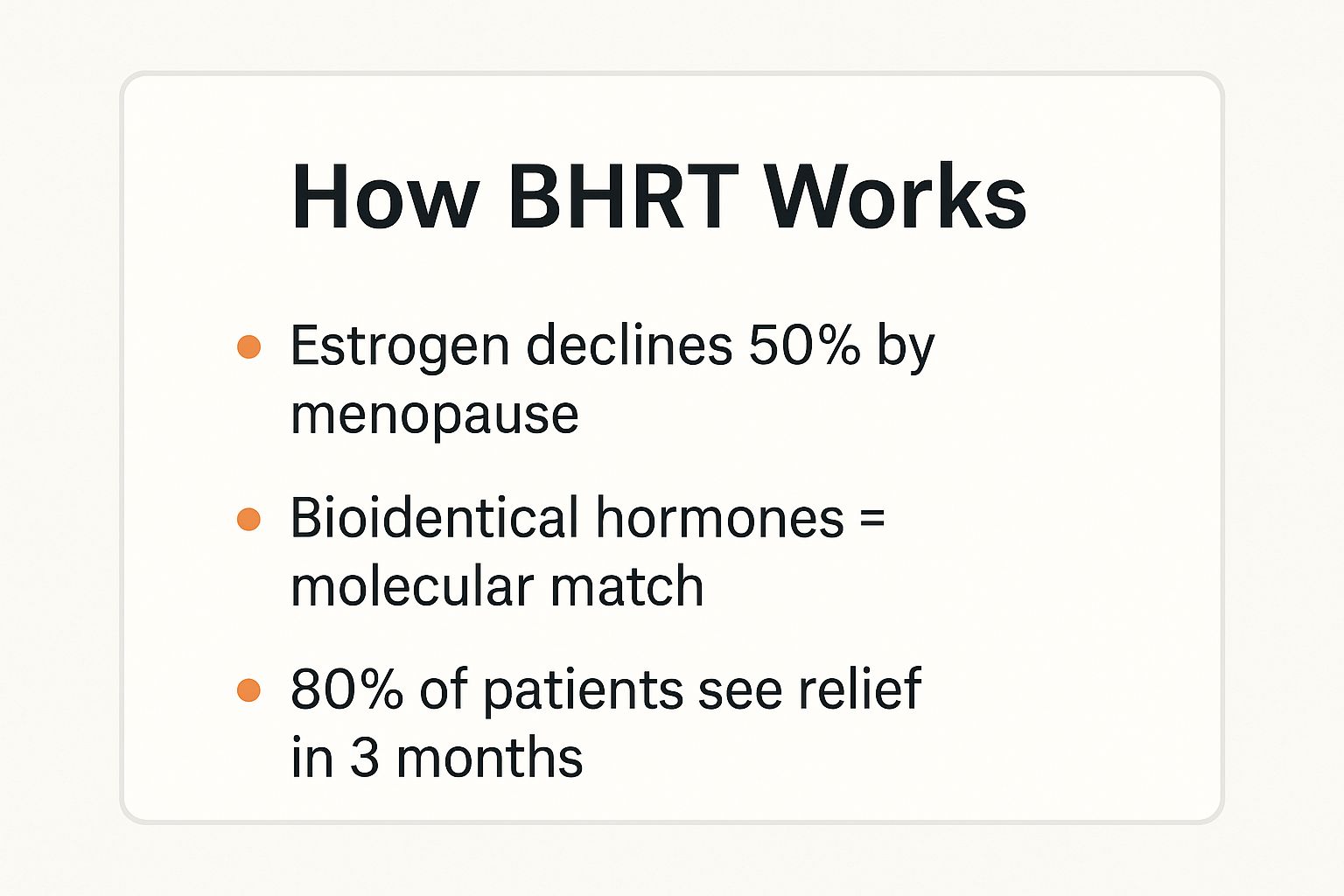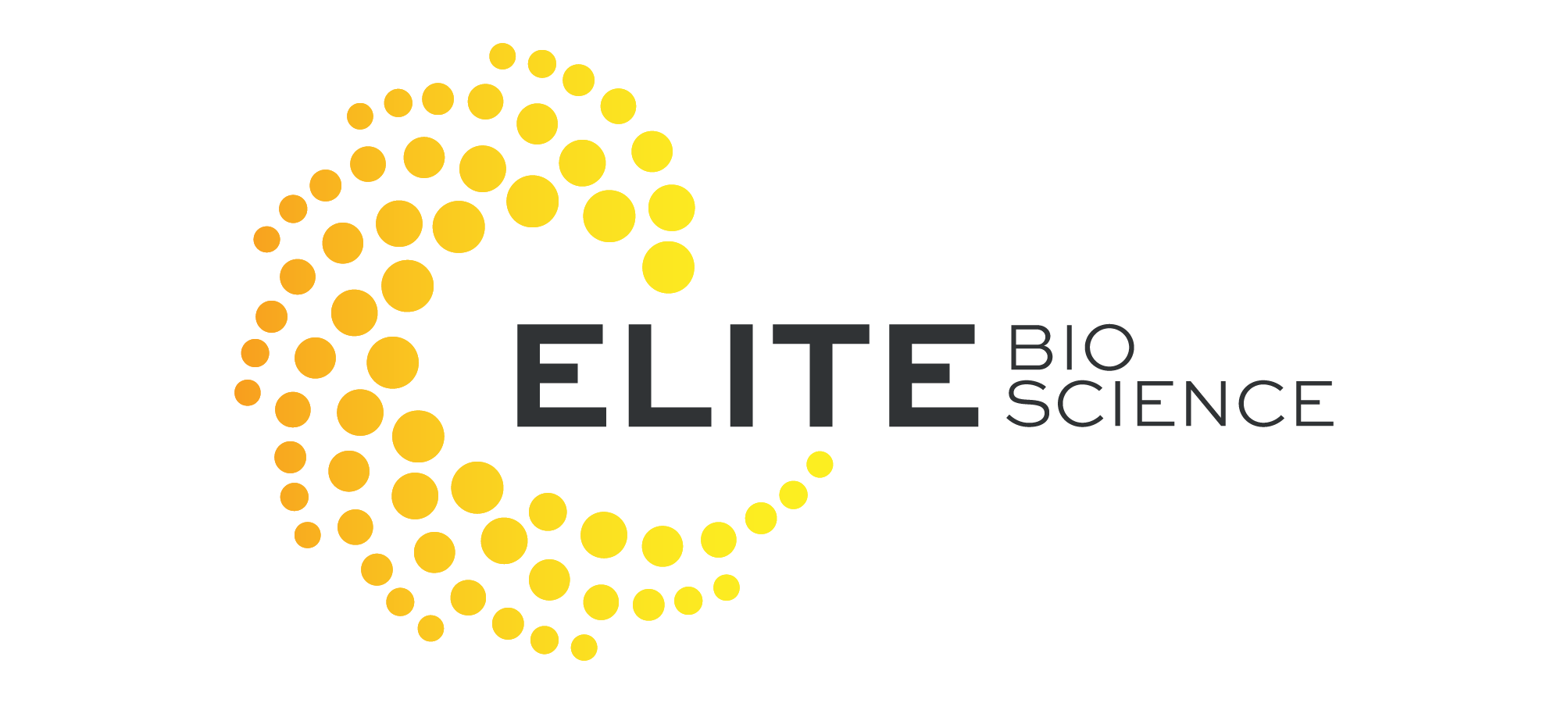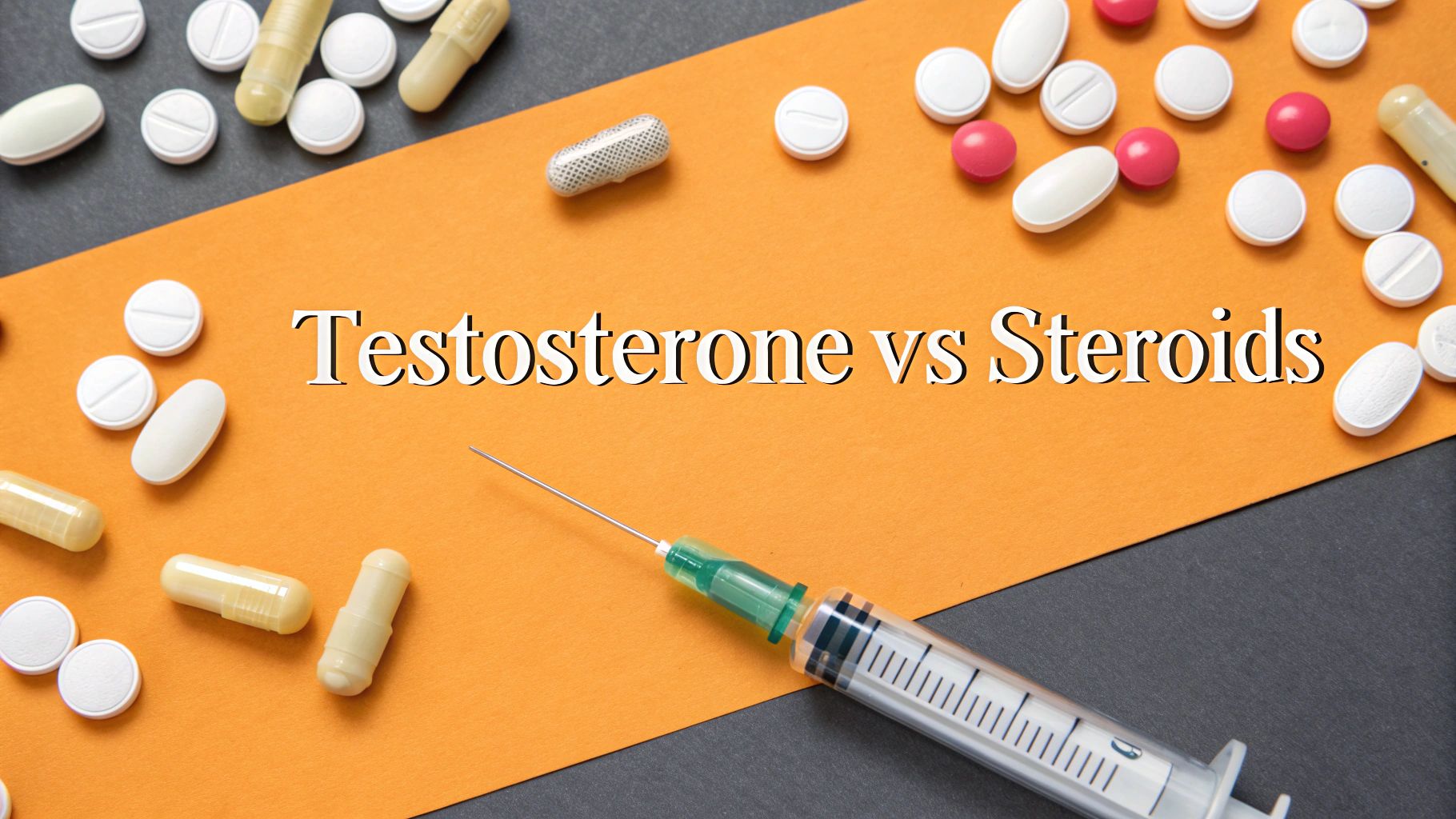Bioidentical hormone replacement therapy is all about using hormones that are a mirror image—molecularly speaking—of the ones your own body makes. Think of it as restoring declining levels with a perfectly matched key for your body's cellular locks, designed to bring back balance and ease the frustrating symptoms that come with hormonal shifts like menopause.
Unlocking Your Body's Natural Balance
At its heart, bioidentical hormone replacement therapy (BHRT) is a way to supplement key hormones like estrogen, progesterone, and testosterone when your natural production drops off. The single most important feature of this therapy isn't where the hormones come from, but their chemical structure. They are crafted in a lab to be exact replicas of the hormones your body produces.
This molecular match is the whole point of BHRT. Imagine your body’s cells have specific "receptor" sites, kind of like locks on a door. Hormones act as the keys, and for a biological process to kick off, the key has to fit the lock perfectly. Bioidentical hormones are designed to be that perfect fit, triggering the exact same physiological response as your own natural hormones would.
Where Do Bioidentical Hormones Come From?
There's a common mix-up that "bioidentical" automatically means "natural." While many bioidentical hormones start from plant sources like yams and soy, the term itself is all about the final molecular structure. These plant-based compounds are chemically processed in a lab until they become indistinguishable from human hormones.
The primary goal of BHRT is twofold: to improve your current quality of life by managing disruptive symptoms and to support long-term health by mitigating risks associated with hormonal decline.
This precision is what allows for truly personalized treatment. After running blood tests to see exactly what your hormone levels are, a practitioner can map out a plan to restore your unique balance instead of handing you a one-size-fits-all solution. This customized strategy is a huge reason for its growing popularity. The image below shows the chemical structures of key hormones, highlighting how the bioidentical versions are a perfect match.

The image clearly shows the nearly identical molecular frameworks of estradiol and progesterone, two hormones central to most BHRT plans.
A Growing Field in Modern Health
The buzz around therapies like BHRT isn't just a fleeting trend; it’s a reflection of major demographic shifts. The global market for hormone replacement therapy was valued at roughly $23.82 billion in 2024 and is on track to hit nearly $47.12 billion by 2035. This growth is being pushed by aging populations and a much deeper understanding of how hormonal balance affects everything from our daily energy to our long-term wellness. As more people demand personalized health solutions, the use of bioidentical hormones is on the rise. You can discover more insights about the expanding hormone therapy market on mordorintelligence.com.
This approach focuses on several key hormones, each playing a distinct part:
- Estrogen: Often the go-to for managing symptoms like hot flashes, night sweats, and vaginal dryness.
- Progesterone: Works alongside estrogen to protect the uterine lining and can also have a big impact on mood and sleep quality.
- Testosterone: Crucial for both men and women, contributing to energy levels, libido, and muscle mass.
- DHEA: A "precursor" hormone that your body can convert into other hormones like estrogen and testosterone as needed.
Getting a handle on these fundamentals is the first step in figuring out if bioidentical hormone replacement therapy might be the right path for you. It's all about restoring what your body is missing with a solution designed to fit you seamlessly.
Bioidentical Vs Synthetic Hormones Explained
When you start looking into hormone replacement, you'll quickly run into two key terms: bioidentical and synthetic. While both are designed to bring your hormone levels back into balance, the real difference is in their chemical design and, most importantly, how your body interacts with them. This isn't just marketing jargon—it's basic chemistry.
Think of your body’s hormone receptors as highly specific locks. The hormones you produce naturally are the master keys, fitting perfectly every time. Bioidentical hormone replacement therapy (BHRT) is all about creating exact replicas of those master keys. Synthetic hormones, on the other hand, are more like a key that’s been cut similarly—it might turn the lock, but the fit isn't quite right.
This distinction is what really matters. Because bioidentical hormones are molecularly identical to the ones your body makes, your system is built to recognize and use them seamlessly. Synthetic hormones have a slightly different chemical structure, which can cause them to interact with your body’s receptors in unpredictable ways, sometimes leading to side effects you wouldn’t otherwise expect.
A Closer Look at Molecular Structure
At its core, the "bioidentical vs. synthetic" debate all comes down to their chemical makeup. Bioidentical hormones, like estradiol and micronized progesterone, are engineered in a lab to be exact copies of human hormones. Even though they often originate from plant compounds found in yams or soy, the final product is structurally identical to what your body would produce on its own.
In contrast, conventional synthetic hormones are not identical. A classic example is Premarin, which is made from the urine of pregnant mares and contains estrogens that are natural to horses, not humans. Another is Provera, a synthetic progestin (which is different from progesterone) that has a completely different molecular shape. This is why many people see bioidentical therapy as a more natural way to restore your body’s equilibrium.
The following infographic breaks down some key data on BHRT and its effectiveness.

The data here makes a strong case: with the significant drop in estrogen that comes with menopause, using hormones that are molecularly identical to our own leads to a very high rate of symptom relief for patients.
Customization and Delivery Methods
One of the biggest advantages of bioidentical hormone replacement therapy is the ability to customize it. Since many bioidentical hormones are prepared at compounding pharmacies, a practitioner can prescribe a dose that’s tailored precisely to your individual needs, based on your blood tests. This level of personalization just isn't an option with mass-produced synthetic hormones, which only come in standardized doses.
The goal is to give your body exactly what it needs to find balance—no more, no less. This tailored dosing helps minimize side effects and optimize your results, steering clear of a one-size-fits-all approach.
This personalized approach also applies to how the hormones are delivered. While both types of hormones can be administered in various forms, bioidentical options often come in formulations that bypass the liver first, such as:
- Transdermal creams or gels: Absorbed directly through the skin into the bloodstream.
- Patches: Provide a slow, steady release of hormones over time.
- Pellets: Tiny implants placed just under the skin for long-lasting effects.
This direct-to-bloodstream absorption can lower the risk of certain side effects, like blood clots, which have been more closely linked with oral estrogen that has to be processed by the liver.
To make the differences even clearer, let’s put the two approaches side-by-side.
Bioidentical vs. Synthetic HRT Key Differences
The table below provides a straightforward comparison of the core characteristics of bioidentical and traditional synthetic hormone therapies.
| Feature | Bioidentical Hormones | Synthetic Hormones |
|---|---|---|
| Molecular Structure | Chemically identical to the hormones your body produces naturally. | Have a different chemical structure from human hormones. |
| Source | Often derived from plant sources (like yams and soy) and processed to match human hormones. | Created from various sources, including animal-derived compounds (e.g., pregnant mare urine). |
| Customization | Can be custom-compounded to match a patient's specific hormonal needs based on testing. | Typically available only in standard, mass-produced doses set by pharmaceutical companies. |
| Body's Recognition | Recognized and metabolized by the body in the same way as its own hormones. | May bind differently to hormone receptors, potentially leading to different effects or side effects. |
Ultimately, understanding these distinctions is key. It empowers you to have a much more informed conversation with your healthcare provider about which type of hormone therapy best aligns with your body, your symptoms, and your overall wellness goals. It’s all about choosing a path that feels right for your unique biology.
The Real-World Benefits of Balancing Your Hormones

Understanding the science behind bioidentical hormone replacement therapy is one thing, but what does it actually feel like when your hormones click back into place? Once you get past the theory, the benefits show up as real, day-to-day improvements that can completely shift your quality of life. This isn’t just about treating one or two symptoms; it’s about feeling like yourself again.
A hormonal imbalance can feel like a slow, constant drain on your life, affecting everything from your energy to your mood. When key hormones like estrogen, progesterone, and testosterone are brought back to their optimal levels, it’s like someone finally turning the lights back on in a house that’s been slowly dimming for years. Suddenly, the clarity and vitality you thought were gone for good start to return.
For many women, the first and most welcome change is freedom from the classic, disruptive symptoms of menopause. Those relentless hot flashes and night sweats that ruin sleep and create constant discomfort often begin to fade away. This happens because stable estrogen levels help regulate your brain's internal thermostat—the hypothalamus—stopping it from overreacting to tiny shifts in your body temperature.
"For healthy women who are younger than 60, and within 10 years of menopause onset… the benefits of treating menopause symptoms with hormone therapy outweigh the risks. Hormone therapy remains the most effective treatment for vasomotor symptoms (VMS) including hot flashes and night sweats." – The Menopause Society
This stabilization means fewer sudden, intense waves of heat during the day and fewer nights waking up drenched in sweat. The result is better, more restorative sleep, which has a positive ripple effect on nearly every aspect of your well-being.
Sharper Thinking and Better Moods
Brain fog, memory lapses, and unpredictable mood swings are some of the most frustrating parts of hormonal decline. Estrogen is a key player in brain health, supporting neurotransmitters like serotonin and dopamine, which are crucial for mood stability and cognitive sharpness. When estrogen levels are balanced, many people find their focus sharpens and their emotional state feels more even and predictable.
At the same time, progesterone has a calming, almost sedative-like quality. When it’s properly balanced with estrogen, it can take the edge off feelings of anxiety and irritability while helping you sink into a deeper, more restful sleep. Instead of feeling like you're on a constant emotional roller coaster, you start to feel more grounded and in control of your reactions.
Renewed Energy and Vitality
That persistent, bone-deep fatigue is another classic sign of hormonal shifts. Testosterone, a vital hormone for both men and women, is a major driver of our energy, motivation, and physical stamina. When your levels are optimized with BHRT, you may notice a remarkable uptick in your day-to-day energy.
This newfound vitality often extends into other parts of life:
- Improved Libido: A low sex drive is a common and often distressing symptom. Restoring testosterone and estrogen to healthy levels can bring back a natural interest in intimacy.
- Enhanced Physical Performance: Testosterone is essential for maintaining muscle mass and bone density. This makes it easier to stay active, build strength, and bounce back from workouts.
- Better Body Composition: Balanced hormones also play a role in how your body metabolizes food and stores fat. BHRT can be a powerful ally in managing a healthy weight. Some also find that other targeted treatments can be a great addition; you can learn more about how peptides can help control cravings in our detailed guide.
Ultimately, the goal of bioidentical hormone replacement therapy is to help you feel like the best version of yourself again. It’s about more than just quieting symptoms—it’s about taking proactive control of your health so you can live a fuller, more vibrant life. By getting to the root cause of the imbalance, BHRT can restore your energy, clear your mind, and give you back the confidence that hormonal chaos can so easily steal.
A Realistic Look at BHRT Risks and Side Effects
Let's have an honest conversation about the risks that come with bioidentical hormone replacement therapy. Any time you start a medical treatment, it's smart to go in with your eyes wide open, understanding both the incredible benefits and the potential downsides. The whole point is to improve your quality of life, but being an informed and empowered patient means looking at the full picture.
When you first begin BHRT, your body goes through what I like to call a "recalibration period." Think about it—your system has gotten used to running on fumes, and suddenly you're refueling the tank. This adjustment can cause some temporary side effects as your body gets used to having optimal hormone levels again.
The great thing is, these initial hiccups are usually mild and easily managed. By working closely with your provider, you can fine-tune your dose until it's just right. The goal of personalized medicine isn't just to give you hormones; it's to find the lowest dose that gets rid of your symptoms without creating new ones.
Understanding Common Initial Side Effects
As your body starts adapting to its new hormonal balance, you might notice a few changes. Don't panic. These are often signs that the therapy is starting to work, but the exact balance isn't quite dialed in yet.
Some of these temporary side effects can include:
- Bloating or water retention: This is a common reaction to estrogen and usually fades as your body adjusts or with a small tweak to your dose.
- Breast tenderness: Just like bloating, this initial response to estrogen therapy typically resolves on its own over time.
- Mood swings or irritability: Your brain chemistry is very sensitive to hormones. Finding the sweet spot between estrogen and progesterone is the key to evening things out.
- Acne or oily skin: This can sometimes happen in response to testosterone, but a simple dose adjustment often clears it right up.
The most important thing during this phase is to keep an open line of communication with your healthcare provider. These aren't red flags that BHRT is failing; they're just signals that your personalized plan needs a small course correction.
Addressing More Serious Health Concerns
Now for the bigger conversation: long-term health risks, especially around cancer and cardiovascular health. A lot of the fear and confusion you see in public comes from older, large-scale studies that made massive headlines and left a lasting, and often misleading, impression.
The most famous of these is the Women's Health Initiative (WHI) study. This research dramatically shaped how doctors and the public thought about hormone therapy for years. One part of the study found that a specific combination of synthetic estrogen and progestin was linked to a higher rate of invasive breast cancer. Over an 11-year follow-up of 16,608 postmenopausal women, the group on this synthetic combo had 385 cases of breast cancer, compared to the group taking a placebo.
But here’s the critical detail that often gets lost: the WHI study primarily used non-bioidentical, synthetic hormones (like Premarin and Provera) in a one-size-fits-all dosage. That’s a world away from modern, personalized bioidentical hormone replacement therapy.
Today's BHRT is fundamentally different. We use hormones that are molecularly identical to your own, prescribe doses based on your unique bloodwork, and often use safer delivery methods like transdermal creams that bypass the liver. While no therapy is ever 100% risk-free, these distinctions matter—a lot.
Continuous check-ins and an open dialogue with your doctor are the cornerstones of a safe treatment plan. This is precisely why monitoring TRT and other hormone therapies is so important for both safety and success. The risks aren't universal; they depend entirely on your personal health history, the exact hormones and delivery methods used, and a treatment plan that is carefully and consistently monitored.
Is Bioidentical Hormone Therapy Right for You?
Deciding whether bioidentical hormone replacement therapy is the right move is a big conversation, and it's one worth having if hormonal shifts are starting to run your life. This therapy isn't a magic bullet for everyone, but for the right person, it can be an absolute game-changer. The key is to understand who stands to benefit the most and who should approach this treatment with a healthy dose of caution.
Think of this as a way to prepare for a productive discussion with a qualified medical professional, not a checklist for self-diagnosis. The ideal candidate for BHRT is usually someone dealing with clear, persistent symptoms of hormonal imbalance that just won't quit.
Who Typically Benefits from BHRT
Most people who find real success with bioidentical hormones are looking for relief from the disruptive symptoms of perimenopause, menopause, or andropause (often called male menopause). If you find yourself nodding along to any of these issues, BHRT might be an avenue worth exploring:
- Persistent Menopausal Symptoms: You're battling the classic signs like hot flashes, night sweats, brain fog, and mood swings that are getting in the way of your daily life and wrecking your sleep.
- Declining Energy and Libido: You've noticed a major drop in your energy, motivation, and sex drive that you can't just blame on a busy schedule or a bad week.
- Unexplained Changes in Body Composition: Despite eating right and exercising, you're struggling with weight gain (especially around the middle) or you're seeing a noticeable loss of muscle mass.
- Desire for Proactive Aging: You’re more interested in a preventative approach to your long-term health, aiming to protect your bone density and support your cardiovascular health as you get older.
This is about so much more than just putting a band-aid on symptoms. It’s about restoring your vitality and getting back to feeling like yourself. The goal is to bring your body back into balance so you can feel more in control of your health journey.
When BHRT May Not Be the Right Choice
Just as important as knowing who benefits is understanding who might not be a good fit. Certain health conditions, known as contraindications, can make hormone therapy too risky. This is why a thorough medical history isn't just a formality—it's absolutely essential before starting any treatment.
It’s crucial to have an honest discussion with your doctor about these factors:
- History of Hormone-Sensitive Cancers: A personal history of breast, ovarian, or uterine cancer is a major reason to avoid this therapy.
- Cardiovascular Health Issues: If you have a history of blood clots, stroke, heart attack, or uncontrolled high blood pressure, the risks of BHRT might outweigh the benefits.
- Liver Disease: Your liver is responsible for processing hormones, so significant liver dysfunction can make hormone therapy problematic and unsafe.
- Unexplained Vaginal Bleeding: This is a red flag that needs to be fully investigated by a doctor before you even consider any type of hormone therapy.
Ultimately, the choice is a deeply personal one, made in partnership with a knowledgeable provider who can help you weigh your individual benefits against any potential risks. A great first step is to get educated on all your options, including how to buy hormone and testosterone therapy online safely and legally, which can connect you with qualified telehealth professionals. This approach ensures you start your journey with expert guidance and a plan built just for you.
How to Get Started with BHRT Through Telehealth

Getting expert care for your hormonal health doesn’t have to mean inconvenient trips to a doctor's office anymore. Thanks to telehealth, you can start your bioidentical hormone replacement therapy journey right from your own home, connecting with specialists who truly understand your needs, no matter where you live. This modern approach gives you privacy, convenience, and direct access to top-tier medical guidance.
The process is refreshingly straightforward and designed to put you in the driver's seat. It begins with finding a trusted online clinic specializing in hormone health and then follows a few simple, guided steps. It’s all about removing the traditional barriers so you can get on the path to feeling your best.
Your Step-by-Step Telehealth Roadmap
Starting BHRT through a telehealth service is a clear and logical process. Each step is designed to give your practitioner the information they need to build a safe, effective, and personalized treatment plan just for you.
Find a Reputable Online Clinic: Your first step is to do a little research. Look for providers with excellent patient reviews, transparent information about their medical team, and clear pricing. A good clinic’s website will detail their entire process, the therapies they offer, and confirm that all their products are third-party tested for quality and safety.
Complete a Confidential Health Assessment: You'll kick things off by filling out a detailed online questionnaire. This covers your medical history, your current symptoms, and what you hope to achieve. This initial intake gives your doctor the essential background information needed for a productive consultation.
Schedule Your Virtual Consultation: Next, you’ll have a one-on-one video call with a licensed medical provider. This is your dedicated time to discuss your symptoms in depth, ask any questions you have, and share your goals for BHRT.
Complete At-Home Lab Testing: Based on your conversation, the clinic will mail a simple at-home testing kit directly to you. You’ll collect a sample—usually a blood spot or saliva—and send it to a certified lab. This gives you a precise, real-time snapshot of your current hormone levels.
Receive Your Personalized Treatment Plan: Once your lab results are ready, your provider will carefully review them along with your health assessment. They will then design a customized bioidentical hormone replacement therapy plan, with specific hormones and dosages tailored to your unique biology.
Vetting Your Provider and Maximizing Your Consultation
Choosing the right partner for your health journey is everything. When you're evaluating a telehealth clinic, make sure to prioritize those that offer ongoing support and easy access to their medical team. Your treatment isn't a one-and-done fix; it's a dynamic process that will likely require fine-tuning along the way.
A key advantage of this modern approach is continuous care. Look for a provider who schedules regular follow-up appointments to monitor your progress, review follow-up lab work, and make any necessary tweaks to your treatment plan to ensure optimal results.
The growth in telehealth is a direct response to a rising demand for more accessible and personalized medicine. In fact, the global bioidentical hormone replacement therapy market was valued at around $7.49 billion in 2024 and is projected to climb to $10.2 billion by 2029. This boom is fueled by a greater focus on personalized health and the convenience that digital platforms provide. You can read the full report about BHRT market growth on thebusinessresearchcompany.com.
When you have your first consultation, come prepared with questions to make sure you feel confident and in control. Ask about the specific hormones they recommend and why, potential side effects, the timeline for seeing results, and the total cost of treatment. This proactive approach ensures you're an active participant in your own care, setting you up for success from day one.
Common Questions About BHRT Answered
Deciding to explore a new health path like bioidentical hormone replacement therapy naturally brings up a lot of questions. Getting clear, straightforward answers is the best way to feel confident and in control as you move forward. Let's walk through some of the most common things people ask when they're considering BHRT.
Most people want to know how soon they'll start feeling better. While every person's body responds differently, the majority of individuals begin to notice subtle, positive shifts within just a few weeks. The real magic, however, often happens around the two- to three-month mark, as your body fully adjusts and your provider fine-tunes your dosages to find that perfect hormonal sweet spot.
How Long Will I Need Treatment?
There's no single answer to this one; the duration of BHRT is a highly personal decision made between you and your healthcare provider. Your treatment length is based entirely on your symptoms, your long-term wellness goals, and most importantly, how you feel.
Some people use BHRT for a few years to get through the most challenging phase of menopause. Others find that continuing on a low-dose plan offers extended benefits they value, like supporting their bone density and cardiovascular health for years to come. The key is consistent monitoring and open conversation, ensuring your therapy evolves right along with you.
FDA-Approved Versus Compounded BHRT
When you start looking into BHRT, you’ll hear about two main types of hormones: those approved by the FDA and those that are custom-compounded. It's really important to understand the difference.
- FDA-Approved BHRT: These are medications mass-produced by large pharmaceutical companies. They have undergone rigorous, large-scale clinical trials for safety and consistency and come in standardized doses.
- Compounded BHRT (cBHRT): These are custom-made for you by a specialized compounding pharmacy, based on a precise prescription from your doctor. This allows for personalized dosages and delivery methods that you just can't get off the shelf.
While compounded hormones offer incredible personalization, they aren't individually FDA-approved, meaning they haven't gone through that same large-scale testing process. This is why choosing a reputable clinic that partners exclusively with accredited compounding pharmacies is absolutely essential for your safety and for ensuring you get a high-quality product.
How Is the Cost of BHRT Determined?
The cost of bioidentical hormone therapy can vary quite a bit, as there’s no one-size-fits-all price tag. Every treatment plan is built from the ground up to meet an individual's unique needs.
The total investment in your health is shaped by the specific needs identified through your lab testing. This approach ensures you only pay for the precise support your body requires to find its optimal balance.
Here’s a breakdown of the factors that typically influence the final cost:
- Initial and Follow-Up Lab Testing: Comprehensive blood work is the foundation for getting a baseline and tracking your progress effectively.
- Provider Consultations: This includes the fees for your initial, in-depth visit and any subsequent follow-up appointments.
- Type and Dosage of Hormones: The cost of the prescribed hormones themselves, which will depend on the type, strength, and delivery method (like creams, pellets, or other forms).
At Elite Bioscience, we believe in transparent, personalized care that puts you in control of your health journey. Our expert medical team is ready to answer all your questions and design a therapy plan that helps you feel your absolute best. Start your confidential health assessment today.







